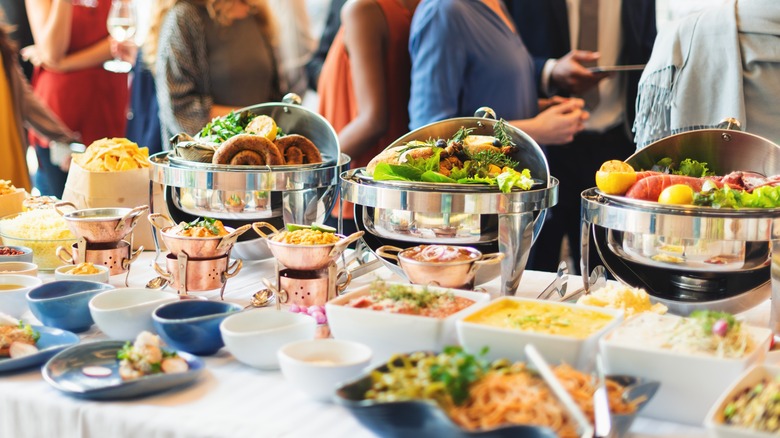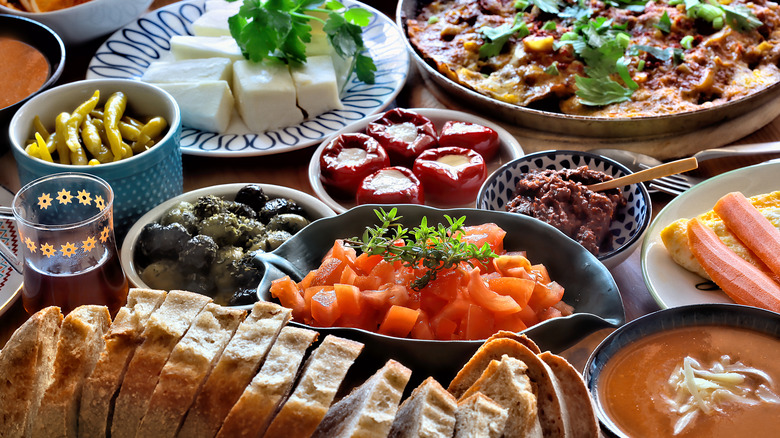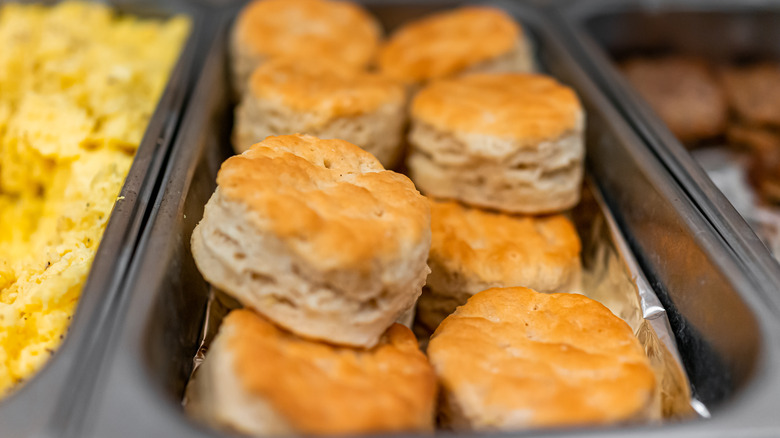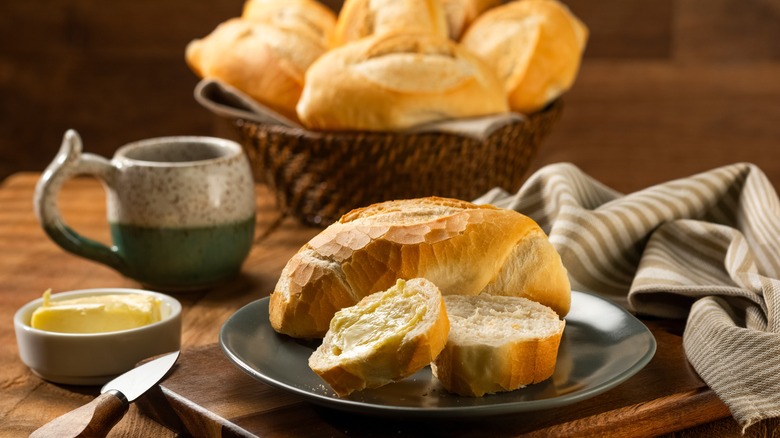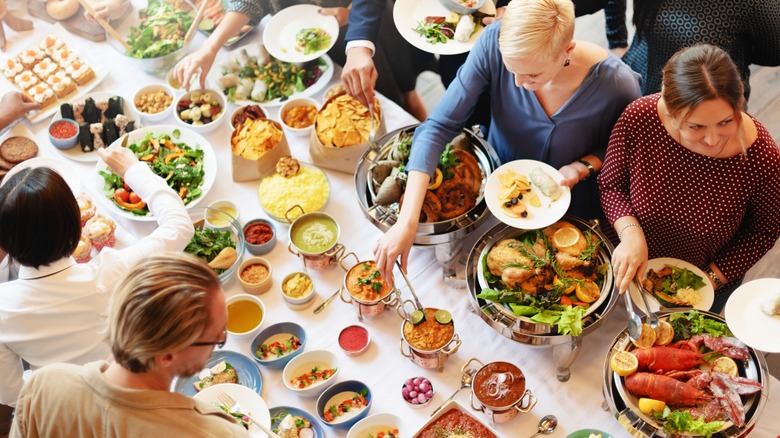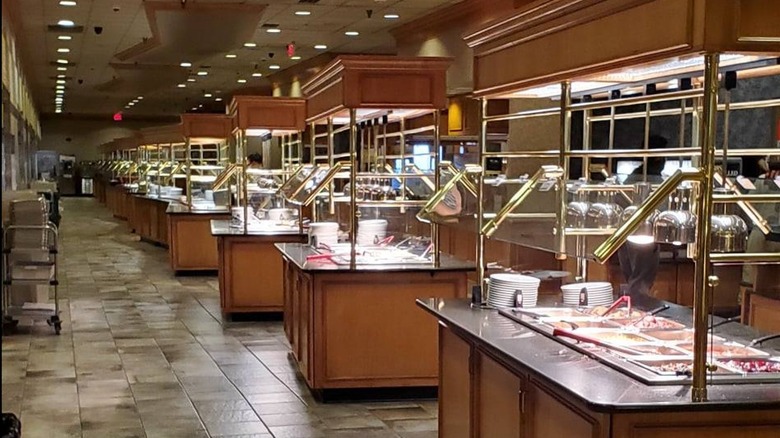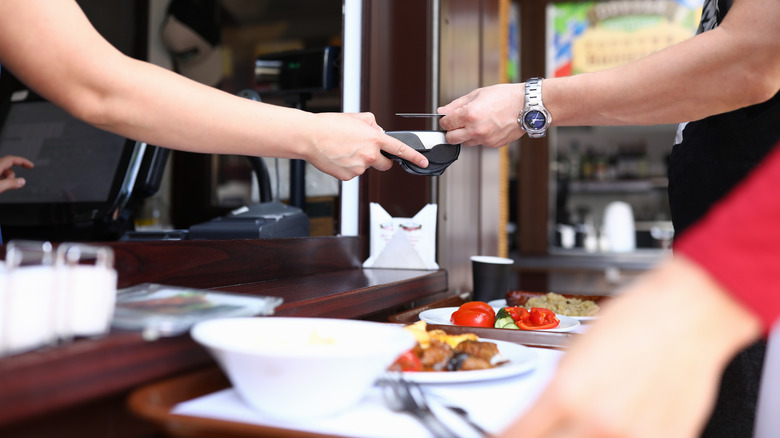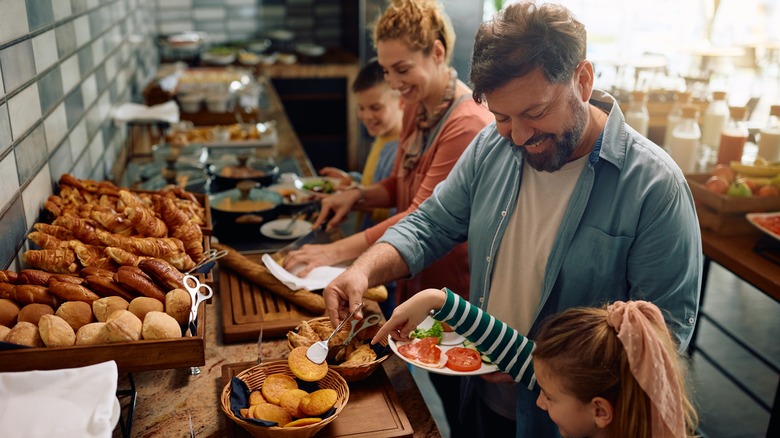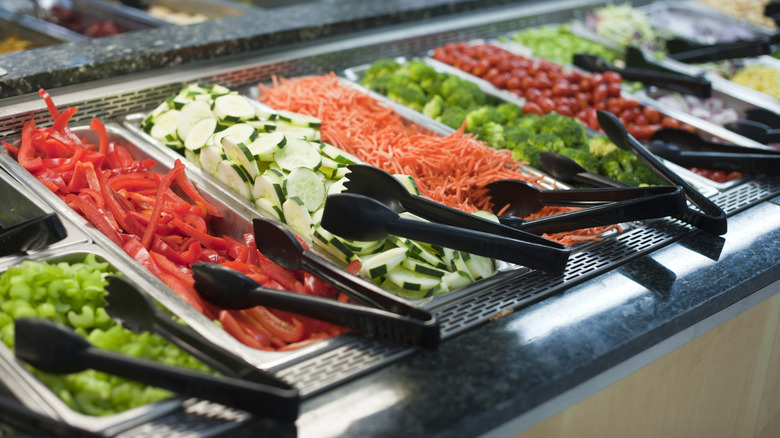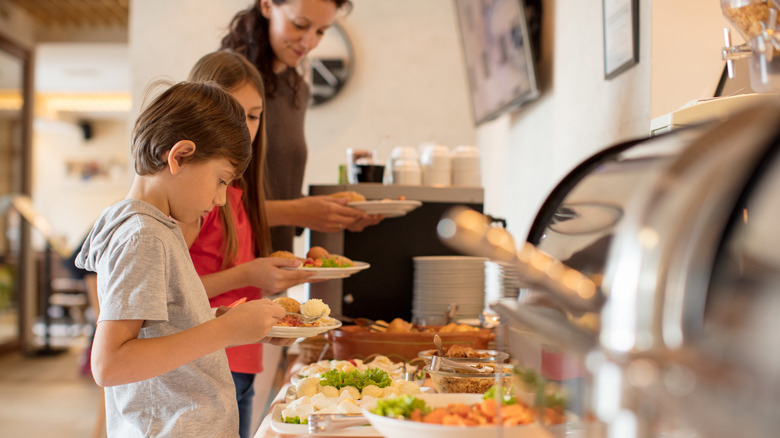12 Fascinating Facts About All-You-Can-Eat Buffets
There's more to the tons of great buffets across the U.S. than just tasty food. For one, it has an interesting history you might want to learn about before you visit your next buffet.
Then, there are some secrets that can translate into tips you can use to get the most out of your next buffet visit. This includes the psychology that goes into maximizing your enjoyment at buffets that keeps you coming back again and again. Plus, there are some things you need to know not only to get the most out of your meal but to stay safe when eating at one. If you're up for a road trip, we've also revealed where you need to go to visit the largest buffet in the country. Whether you're a buffet newbie or an old pro at making the most of your buffet experience, these fascinating facts will change the way you look at all those mountains of food.
Sweden introduced the concept of buffets
The inspiration for buffets in the U.S. came from Europe. One place where you would have seen something similar to the buffet concept in Europe early on was the wide array of foods available at medieval feasts. Then, in the 1500s, Swedes started offering a brännvinsbord to guests as an appetizer, which consisted of a spicy vodka called brännvin and light dishes like bread, cheese, and dried meats. From this grew the idea of offering a wider variety of hot and cold dishes and turning it into a whole meal, which the Swedes named smörgasbord. There's an order to the way the dishes are arranged, and etiquette requires guests to take only small amounts and eat foods in a special order so that it's not a free-for-all.
Sweden first introduced the world to its smörgasbord concept when the Olympics was held in Stockholm in 1912. However, it was when they brought it to the 1939 World's Fair in New York that it began to inspire Americans. While the inventor of the all-you-can-eat buffet in the U.S. likely didn't attend the World's Fair, he opened his first one only about seven years after the World's Fair.
All-you-can-eat buffets started in Vegas
Everything's a little more intense in Las Vegas, which is why you'll probably not be surprised that the idea of an all-you-can-eat buffet restaurant began there. While the first one is no longer around, the idea lived on in Vegas, where you can now find dozens.
The very first all-you-can-eat buffet tends to be attributed to Herb McDonald. He supposedly stumbled onto the idea accidentally in 1946, when he had some sandwich fixings out on the bar at the El Rancho Vegas hotel to make himself a sandwich and activated the appetites of some Vegas casino gamblers walking by. Realizing he could capitalize on it, McDonald created a late-night Chuck Wagon buffet to satisfy the midnight cravings of guests. Well, technically, it was open from 1:00 a.m. until 4:00 a.m., after which the hotel switched to serving breakfast. You could eat from that first rudimentary buffet for only $1.25.
Interestingly, four years earlier, in 1942, Hotel Last Frontier offered a snack bar for people who were hungry late at night, too. So, while El Rancho Vegas wasn't quite the first to offer a food spread to guests, it was the one that started the Vegas buffet trend after opening a 24-hour version called the Buckaroo Buffet. With a $1 buffet open all hours of the day, gamblers never had to leave.
Many fast food restaurants have or once had buffets
There was a time in U.S. history when lots of fast-food restaurants offered buffets. Some even still exist.
Certain fast food buffets have been more widespread than others. Wendy's started with a potato bar and then expanded with a Superbar in the 1980s. It offered pasta, garlic bread, Mexican food, salad, potatoes, steamed broccoli, and chili. Plus, there was dessert. Popeye's had a few, but the last buffet operation (in Lafayette, Louisiana) ended during the COVID-19 pandemic. Some people also remember fast food buffets that weren't as widespread. For example, there seems to have been a breakfast buffet at some McDonald's in the 1990s. Taco Bell was even rumored to have had a buffet in a couple of locations in the 1980s or 1990s, allowing you to make your own creations with the given ingredients.
Still, a select few fast food buffets remain open. Apparently, there are still buffets open at a few KFCs featuring the same food you see on the regular menu, plus Southern food items like fried okra, black-eyed peas, rice, cobblers, and pudding. Some pizza places like Pizza Hut, Simple Simon's, and Mazzio's still have lunch or dinner buffets with pizza, salads, and desserts.
Some buffets use tricks to get you to eat less
Even though there's loads of food available at an all-you-can-eat buffet, the idea is to fill you up before you can get a chance to try everything. So, buffets have a few tricks up their sleeves to get you to eat less.
The first trick buffets use is to get you to fill up on less expensive items. If they keep refilling your glass (especially your water glass), it's in an attempt to get you full faster. Some buffets will put bread on the table to help fill you up. Or you'll find cheaper foods like bread, potatoes, salad, and pasta toward the beginning of the buffet, where most people get the majority of their food. And those cheaper foods have bigger spoons so that you give yourself a more generous portion. Meanwhile, the more expensive foods are probably still in the kitchen being prepared because they've just run out, or you have to wait for them to be custom-made. So, you could twiddle your thumbs and wait 15 more minutes for them, but you're more likely to choose something else instead. You're also likely eating off a smaller plate at a buffet to make it feel as if you're eating more.
Buffets still profit despite customers eating all they want
Many people walk into a buffet with the intention of getting their money's worth by indulging more than they usually would. So, it's easy to wonder how buffets still profit.
As previously mentioned, there are tricks that buffets use to get you to eat less or cheaper food, but they also employ other strategies to stay profitable. For example, they make money when you buy a drink. Of course, sourcing cheaper ingredients in bulk and having a fixed menu helps cut costs, too. Another way that they make money is that there are fewer employees to pay with a buffet restaurant model. Sure, there's lots of food made all the time, but serving yourself reduces the number of employees needed.
While there are certainly a few people who eat so much food that its value is more than what they paid, it balances out with those who eat less. There are also regulars who come in for comfort and don't eat a whole lot, as well as seniors and children who aren't eating nearly as much. Plus, even if there isn't a huge profit margin on food, owners can make up for it by having tons of people come through, thus increasing profits.
A Thai buffet set a world record with thousands of dishes
On September 9, 2017, some lucky people got to partake in a buffet that made it into the Guinness Book of World Records as the largest buffet in the world. The buffet was for the Samui Festival, a tourist event celebrating the 120th anniversary of the founding of Thailand's Samui Island. The buffet tables stretched over a mile and a half down the beach, and it was free for anyone who wanted to partake.
Chefs from around the world created over 10,000 dishes for the event. In the end, only 5,829 of the 6,863 dishes they submitted for the record actually qualified in the final count because several were considered to be duplicate dishes. Still, with over 30,000 people in attendance, there was still plenty of food.
The biggest buffet in operation is an Amish one
While the record-breaking Thai buffet was a one-time event, there's an enormous buffet you can still experience if you're ever in East Earl, Pennsylvania. The current largest all-you-can-eat buffet in the U.S. is called Shady Maple Smorgasbord. It's Amish, and it's been around for over 50 years. For an idea of how popular it is, in 2023, 1.2 million people ate there.
The Shady Maple Smorgasbord started in 1985. It's grown over the years such that a total of 1,200 people at a time can eat at the buffet now. There are 200 feet of food for customers to eat, situated in a building that is 110,000 total square feet. This square footage includes a 44,000-square-foot gift shop and the Fast Food Dutchette on the bottom floor. In 2005, the restaurant added a banquet and conference center. It offers catering, and there's also a farm market and cafe. Altogether, the complex employs over 750 people.
All the food on the buffet at the Shady Maple Smorgasbord is Pennsylvania Dutch style. There are separate breakfast, lunch, and dinner menus, with a different feature menu every night of the week. Plus, you can eat there for free on your birthday with friends.
The psychology behind the price of buffets
There's more to the price of buffets than just what the food costs and the profit margin the owners want to make. There's also some tricky psychology involved because people might think a buffet won't be as good if it's really cheap.
Interestingly, a study from the Journal of Sensory Studies from 2014 discovered that people tend to enjoy buffets more when they cost more. In these experiments, the researchers had some buffet diners pay $4 and others pay $8 for the same Italian lunch buffet. Despite the food being identical, the ones who paid less enjoyed it less, thought it wasn't as tasty, and left feeling less satisfied. The thought is that people anticipate lower-value food when they pay less and higher-value food when they pay more. However, it turned out that the more they ate, the more satisfied they were. So, if you feel like you're getting your money's worth, you might still enjoy it even if it's cheap. The challenge buffet owners have is finding a balance point where customers eat enough (but not too much) and are charged enough to believe in the quality (but not too much to go elsewhere).
The psychology behind the concept of all-you-can-eat buffets working well
There are several reasons why people like to eat at buffets. The overall experience provides a lot of avenues for satisfaction.
At the top of the list, of course, is the variety of food. Not only is there a potential for lots of choices to cater to your cravings, but there's also the possibility of trying new things. Price is also important. People see buffets as good value since you can get all you can eat for one price. It's especially alluring if you're on a budget and want to enjoy a nice meal at a reasonable price tag and feel you can get more value from it than it actually costs you. Customers also like to control exactly what goes on their plate and how much, which is something you usually only get at home or in assembly-line-style restaurants.
Happiness is also a factor. When you see all that food piled up, and you've paid a reasonable price to partake in all that good food, your happiness level goes up, especially if the food is tasty. If you want to chase that feeling of happiness again, you're likely to return.
Your food choices at an all-you-can-eat buffet can be very telling
When you go to a buffet, do you tend to get the same types of things every time? It turns out that what you like to eat when given unlimited choices can reveal a lot about your future body health.
A 2021 study in Appetite analyzed non-obese young adult buffet goers and their choices of several categories of food. It turned out that those who chose more hyper-palatable foods with lots of carbs and sodium when they visited a buffet were more likely to have more body fat and weigh more a year later than those who chose other items to eat. Even those who chose energy-dense, ultra-processed, or hyper-palatable foods with lots of fat and sodium didn't have the same weight and fat gains.
KU News talked to the lead author of the study, Tera Fazzino, who said, "Hyper-palatable foods have combinations of ingredients that can enhance a food's palatability and make a food's rewarding properties artificially strong. Common examples would be various chocolates, hot dogs, pretzels, or brownies — foods that can be difficult to stop eating." Hyper-palatable foods high in carbs and sodium include popcorn, pretzels, pizza, and cheeseburgers. The conclusion the study made was that these buffet choices can be an indication of a tendency toward "hedonistic," out-of-control eating habits, which can lead to weight and fat gain over time if not kept in check.
Some dishes on buffets can be sketchier than others
With so many people in one place helping themselves to so many dishes and touching everything, you might have concerns about how safe buffets are. The fact that so many closed down during the COVID-19 pandemic is a testament to how much people worried about them. However, there are specific red flags at a buffet to watch out for to ensure you're eating safe food.
Food safety is a top consideration when eating at a buffet. So, you should be watching what both employees and customers are doing with the food. Food is especially concerning if it's been sitting around too long at the wrong temperature (between 40 and 140 degrees Fahrenheit). If hot food is lukewarm or cold food is in a puddle of water instead of on ice, steer clear. Also, avoid food if servers are adding new food on top of old or if it looks old, wilted, or unappetizing. Skip the dish that other customers have been directly touching. And steer clear if customers use their own utensils rather than serving utensils to put food on their plate — especially if they're not even using a new plate.
There are a few specific foods that are more risky, too. Sprouts, anything that contains eggs, and anything that is uncooked is especially iffy. While salad bars or sushi are often included in buffets, raw food is always risky since it hasn't been cooked to kill bacteria.
All-you-can-eat buffets are making a big comeback
Even before the COVID-19 pandemic, buffets were seemingly on their way out. According to the NPD Group (via Business Insider), you could find 26% fewer buffets to visit in 2017 than in 1998. Ultimately, many of these declines led to location closures and sometimes even bankruptcies — sometimes even multiple bankruptcies. There are several guesses as to why people just weren't eating at buffets anymore, ranging from health perceptions, fear of food poisoning, or not being appealing to the younger generation.
However, just a couple of years after people were avoiding buffets because of the pandemic, buffets started to see a turnaround as it became a multi-billion-dollar industry. Restaurant expert Robin Ganon gave Today two reasons why buffets are starting to thrive again. "It's family and it's budget," he said. "You have a wonderful selection of items, based on only one price. You know what it's going to cost you to get in and get out." It also goes back to the psychology of feeling like you're getting a good deal, especially when restaurant prices are becoming so high. If you can pay the same amount or less for all-you-can-eat as you can for a meal at your local restaurant (or even fast food), which one are you going to choose? Often, choosing the buffet is a no-brainer, especially if you're trying to please multiple people at once.
